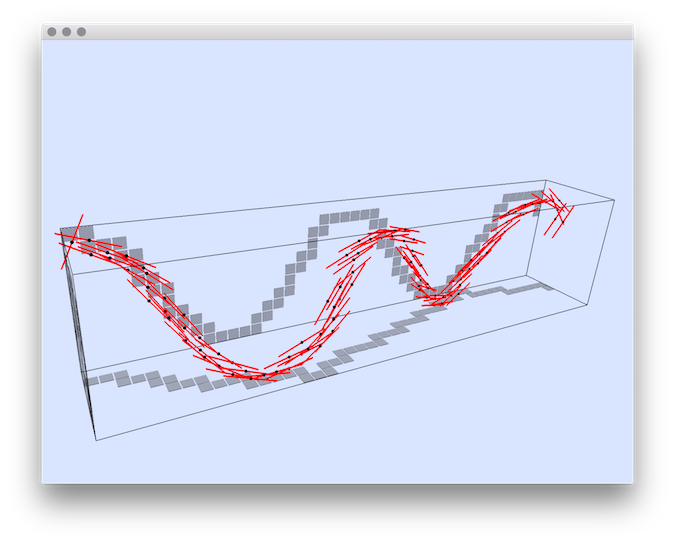This program estimates the tangent vector to a set of 3D integer points, which are supposed to approximate a 3D curve.
Usage: ./estimators/3dCurveTangentEstimator [options] –input <filename>
This program estimates the tangent vector to a set of 3D integer points, which are supposed to approximate a 3D curve. This set of points is given as a list of points in file <input>. The tangent estimator uses either the digital Voronoi Covariance Measure (VCM) or the 3D lambda-Maximal Segment Tangent (L-MST). This program can also displays the curve and tangent estimations, and it can also extract maximal digital straight segments (2D and 3D).
- Note
- It is not compulsory for the points to be ordered in sequence, except if you wish to compute maximal digital straight segments. In this case, you can select the connectivity of your curve between 6 (standard) or 26 (naive).
Allowed options are :
-h [ --help ] display this message
-i [ --input ] arg the name of the text file containing
the list of 3D points: (x y z) per
line.
-V [ --view ] arg (=OFF) toggles display
ON/OFF
-b [ --box ] arg (=0) specifies the the tightness of the
bounding box around the curve with a
given integer displacement <arg> to
enlarge it (0 is tight)
-v [ --viewBox ] arg (=WIRED) displays the bounding box, <arg>=WIRED
means that only edges are displayed,
<arg>=COLORED adds colors for planes
(XY is red, XZ green, YZ, blue).
-T [ --connectivity ] arg (=6) specifies whether it is a 6-connected
curve or a 26-connected curve: arg=6 |
26.
-C [ --curve3d ] displays the 3D curve
-c [ --curve2d ] displays the 2D projections of the 3D
curve on the bounding box
-3 [ --cover3d ] displays the 3D tangential cover of the
curve
-2 [ --cover2d ] displays the 2D projections of the 3D
tangential cover of the curve
-n [ --nbColors ] arg (=3) sets the number of successive colors
used for displaying 2d and 3d maximal
segments (default is 3: red, green,
blue)
-t [ --tangent ] displays the tangents to the curve
-R [ --big-radius ] arg (=10) the radius parameter R in the VCM
estimator.
-r [ --small-radius ] arg (=3) the radius parameter r in the VCM
estimator.
-m [ --method ] arg (=VCM) the method of tangent computation: VCM
(default), L-MST.
-o [ --output ] arg (=3d-curve-tangent-estimations)
the basename of the output text file
which will contain points and tangent
vectors: (x y z tx ty tz) per line
Example: This command line show an example of tangent estimation with the VCM estimator.
3dCurveTangentEstimator -i ${
DGtal}/examples/samples/sinus.dat -V
ON -c -R 20 -r 3 -T 6
You should obtain such a result:

Resulting tangent vectors (red) obtained with the VCM estimator.
- See also
- 3dCurveTangentEstimator.cpp

 1.8.10
1.8.10